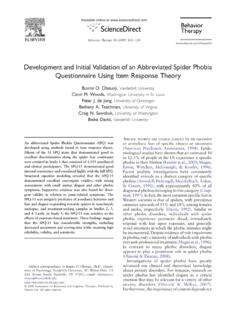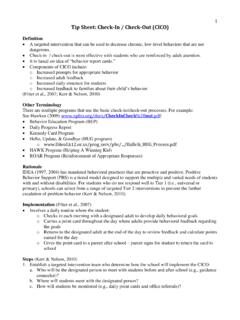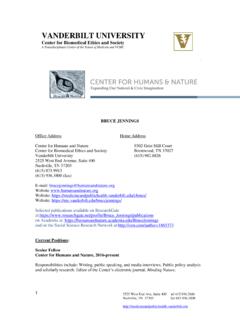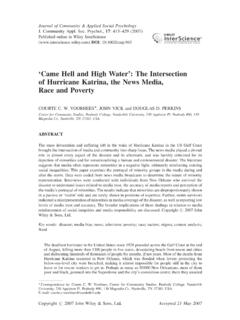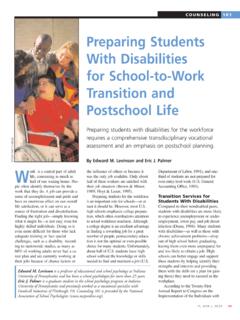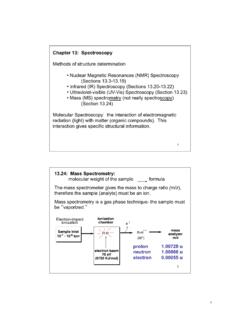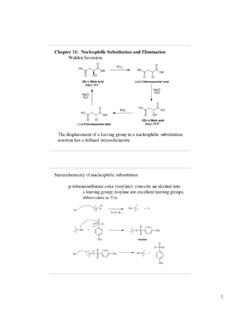Transcription of Math Curriculum Based Measurement - my.vanderbilt.edu
1 Curriculum Based Measurement is a standardized and systematic method of formative assessment; CBM is an empirically validated method of progress monitoring with over 25 years of research on effectiveness of CBM CBM has been linked to: Characteristics of CBM: Improved student academic outcomes More effective instruction Higher student achievement Increased student responsibility for learning Relationship between CBM and high stakes testing Better communication between parents and teachers (Fuchs, Deno, Mirkin, 1984.)
2 Fuchs, Fuchs, & Hamlett, 1993, Good, Simmons, & Kameeuni, 2001) Used to monitor student progress across an entire year Probes are brief and easy to administer Administered weekly or as benchmarks and administered the same way each time Each probe samples Curriculum for an entire school year Each probe is different, but each form assesses the same types of skills at same level of difficulty CBM can be used to: o Monitor student learning outcomes o Identify at-risk students o Evaluate intervention effectiveness o Guide instruction and cue instructional changes o Measure AYP o Monitor annual goals and objectives (L.
3 S. Fuchs & Fuchs, 2004; L. S. Fuchs, Fuchs, Hamlett, & Stecker, 1990; Hosp & Hosp, 2003) Math CBM Steps (Fuchs & Fuchs, 2005) Step 1: Determine math CBM task for progress monitoring Step 2: Identify level of material Step 3: Administer and score Step 4: Graph scores Step 5: Set ambitious goals Step 6: Apply data decision rules Math Curriculum Based Measurement Step 1: Determine math CBM task for progress monitoring (Fuchs & Fuchs, 2005; Hosp, Hosp, & Howell, 2007) Types of Math CBM Grade Type Descriptor Admin Score K 1st Grade Early numeracy for students do not know basic facts or are unable to compute concepts & applications Note.
4 Technical adequacy still being evaluated Number Identification Orally identify numbers between 1 and 100 Individually 1 minute Total numbers correctly identified Missing Number Identify missing number in 4-number sequence Individually 1 minute Total numbers correctly identified Quantity Array Identify the number of dots in a box Individually 1 minute Total numbers correctly identified Quantity Discrimination Identify larger number from set of two number Individually 1 minute Total numbers correctly identified Grades 1 6 Use computation probes until the concepts & applications probes are appropriate for the grade-level Curriculum material Select a task for CBM progress monitoring & use same task (level and type of probe) for the entire year See below for resources to find probes Computation Single or multi-skill probes Individually or in groups Number of digits correct Grades 2 6 Concepts & Application Multi-skill probes that include 18-25 problems- more than just computation ( , Measurement , time, graph interpretation)
5 Individually or in groups Time varies by grade: 2nd - 8 minutes 3rd - 6 minutes 4th - 6 minutes 5th - 7 minutes 6th - 7 minutes Total number of blanks correct Step 2: Identify level of material (Fuchs & Fuchs, 2005) 1) Use computation or concepts and application probes at expected grade level OR 2) Administer two probes at the grade level below the expected grade level (on separate days and be sure to use the correct time administration for the probe): If the student s average score is between 10 and 15 digits or blanks correct, use this lower grade-level probe If the student s average score is less than 10 digits or blanks correct, either move down one more grade level or stay at the original lower grade and repeat this step If the average score is greater than 15 digits or blanks correct, reconsider moving to grade-appropriate probe Stay on same grade level for the entire school year Step 3.
6 Administer and score Math CBM Materials (adapted from Hosp & Hosp, 2003) 1) Math probe sheets (see below for resources to find probes) a. 2 copies of each probe sheet (one for student & one for teacher with correct answers). b. At least 25 problems that sample the year s math Curriculum . c. Each probe sheet should be different but equivalent in grade level/difficulty with the same number of problems representing each skill d. Items on probe sheets are randomly ordered but each sheet has the same random order. e. Single-skill probes are another option useful for short-term planning when students are learning a new skill.
7 2) A stop watch or countdown timer 3) Directions to administer the probes 4) A graph to plot the data Math CBM Directions: It is important that teachers correctly administer each CBM probe. If a teacher changes the directions when administering CBM probes, it can invalidate the results. For additional information on administration and oral directions, please see: Hosp, Hosp, & Howell (2007) Fuchs & Fuchs (2005) Step 4: Graph scores (Fuchs & Fuchs, 2005) Two options: 1) Paper and pencil graphs a. Vertical axis - include the range of scores of all students in the class from zero to the highest score.
8 Horizontal axis - include the number of weeks of instruction o Highest scores for vertical axis Quantity Array 36 Number Identification 84 Quantity Discrimination 63 Missing Number 63 Computation 25 (problems correct) with 30 80 (digits correct) Concepts and Applications 50 b. Make a template of the above and one copy for each student 2) Chart Dog ( ): Web- Based data storage and management 3) Commercial CBM materials (see below under Premade Math CBM Probe Sheets) Step 5: Set ambitious goals (Fuchs & Fuchs, 2005; Hosp, Hosp, & Howell, 2007) There are several options in goal setting: 1) Using benchmarks: Using the Math CBM Benchmarks table below, determine the end of year benchmark (performance goal).
9 Graph the three baseline scores and the end of year benchmark. Draw a goal line on the graph from the median score to the benchmark. 2) Using norms: Using the Math CBM Weekly Growth Rates table and the formula to calculate goal. Graph the three baseline scores and the end of year goal. Draw a goal line on the graph from the median score to the benchmark. Initial median score + (growth rate x number of weeks of instruction) Example: 55 (initial median score) + (.75 [weekly growth rate] x 30 weeks) = (goal) Math CBM Benchmarks Grade Probe Benchmark 1st Computation 20 digits 2nd Computation 20 digits 2nd Concepts & Application 20 blanks 3rd Computation 30 digits 3rd Concepts & Application 30 blanks 4th Computation 40 digits 4th Concepts & Application 30 blanks 5th Computation 30 digits 5th Concepts & Application 15 blanks 6th Computation 35 digits 6th Concepts & Application 15 blanks Math CBM Weekly Growth Rates.
10 Correct Digits Grade Realistic Weekly Growth Rates Ambitious Weekly Growth Rates 1st 2nd 3rd 4th 5th 6th Step 6: Apply data decision rules See the table below: Making Decisions using CBM Data Look at the last 3 data points. If the data points are: Close to the goal line (all on the line, or some above and some below) Continue your instruction as implemented If your student has an increasing slope with gains at or near your aimline, then he/she is responding to your instruction - so keep doing what you are doing All below the goal line Change your instruction If at least 3 consecutive scores have fallen below the aimline, the student is not responding optimally to instruction.
